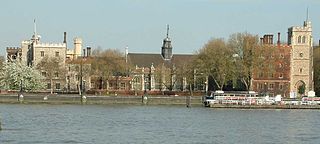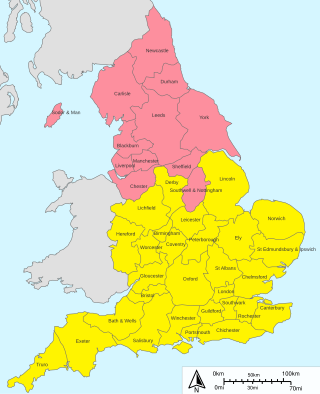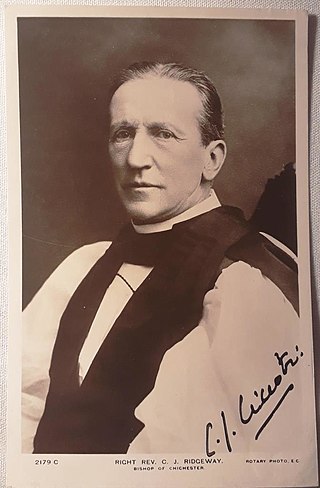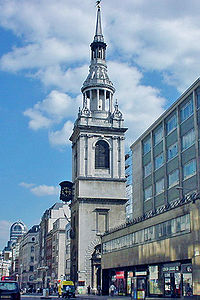
The archbishop of Canterbury is the senior bishop and a principal leader of the Church of England, the ceremonial head of the worldwide Anglican Communion and the bishop of the Diocese of Canterbury. The current archbishop is Justin Welby, who was enthroned at Canterbury Cathedral on 21 March 2013. Welby is the 105th person to hold the position, as part of a line of succession going back to the "Apostle to the English" Augustine of Canterbury, who was sent to the island by the church in Rome and arrived in 597. Welby succeeded Rowan Williams.

John Peckham was a Franciscan friar and Archbishop of Canterbury in the years 1279–1292.
An ecclesiastical court, also called court Christian or court spiritual, is any of certain courts having jurisdiction mainly in spiritual or religious matters. In the Middle Ages, these courts had much wider powers in many areas of Europe than before the development of nation states. They were experts in interpreting canon law, a basis of which was the Corpus Juris Civilis of Justinian, which is considered the source of the civil law legal tradition.

A consistory court is a type of ecclesiastical court, especially within the Church of England where they were originally established pursuant to a charter of King William the Conqueror, and still exist today, although since about the middle of the 19th century consistory courts have lost much of their subject-matter jurisdiction. Each diocese in the Church of England has a consistory court.

Lambeth Palace is the official London residence of the Archbishop of Canterbury. It is situated in north Lambeth, London, on the south bank of the River Thames, 400 yards south-east of the Palace of Westminster, which houses Parliament, on the opposite bank.

In Christian churches with episcopal polity, the rank of metropolitan bishop, or simply metropolitan, pertains to the diocesan bishop or archbishop of a metropolis.
A royal peculiar is a Church of England parish or church exempt from the jurisdiction of the diocese and the province in which it lies, and subject to the direct jurisdiction of the monarch.
The Dean of the Arches is the judge who presides in the provincial ecclesiastical court of the Archbishop of Canterbury. This court is called the Arches Court of Canterbury. It hears appeals from consistory courts and bishop's disciplinary tribunals in the province of Canterbury.

The Province of Canterbury, or less formally the Southern Province, is one of two ecclesiastical provinces which constitute the Church of England. The other is the Province of York.

The Diocese of Canterbury is a Church of England diocese covering eastern Kent which was founded by St. Augustine of Canterbury in 597. The diocese is centred on Canterbury Cathedral and is the oldest see of the Church of England.
The appointment of Church of England diocesan bishops follows a somewhat convoluted process, reflecting the church's traditional tendency towards compromise and over complex solutions, traditional ambiguity between hierarchy and democracy, and traditional role as a semi-autonomous state church.
The Court of Ecclesiastical Causes Reserved is an appellate court within the hierarchy of ecclesiastical courts of the Church of England. Hearing cases involving church doctrine, ceremony, or ritual, the court has jurisdiction over both the Province of Canterbury and the Province of York. Appeals from the court are heard in a Commission of Review.
In canon law the confirmation of a bishop is the act by which the election of a new bishop receives the assent of the proper ecclesiastical authority.
The Court of Peculiars is one of the ecclesiastical courts of the Church of England. The court sits with a Dean, who is also the Dean of the Arches. The Registrars are the Joint Provincial Registrars. The Court of Peculiars deals with all legal matters from peculiar parishes in the province. Until 1545, ecclesiastical judges were required to have a degree in canon law; thereafter, they only needed a doctorate in civil law. Binding precedent was only introduced into the ecclesiastical courts in the nineteenth century.
The Chancery Court of York is an ecclesiastical court for the Province of York of the Church of England. It receives appeals from consistory courts of dioceses within the province. The presiding officer, the Official Principal and Auditor, has been the same person as the Dean of the Arches since the nineteenth century. The court comprises the auditor, two clergy, and two laity, as for the Court of the Arches in the Province of Canterbury. The registrar is distinct, however, and is at present Louise Connacher.
The Court of the Vicar-General of the Province of Canterbury is responsible for granting marriage licences in the Province of Canterbury of the Church of England. The Vicar-General is distinct from the Dean of the Arches. The Registrars are the Joint Provincial Registrars. A Vicar-General is appointed by the Archbishop, and by certain other bishops to assist with such matters as ecclesiastical visitations. The Vicar-General of the Diocese is distinct from the Vicar-General of the Province. The Registry of the Vicar-General of the Province is 16 Beaumont Street, Oxford OX1 2LZ.
William Lyndwood was an English bishop of St. David's, diplomat and canonist, most notable for the publication of the Provinciale.
Within the Catholic Church, an ecclesiastical judge is an ecclesiastical person who possesses ecclesiastical jurisdiction either in general or in the strict sense. The judge presides over all baptized persons within their jurisdiction.

Charles John Ridgeway was an English churchman, the Bishop of Chichester from 1908 to 1919.
William Fleshmonger(? -1541/42), the son of a Winchester College tenant, was born in Hambledon, Hampshire. He was a Doctor of Canon Law and Dean of Chichester during the turmoil of the English Reformation.








